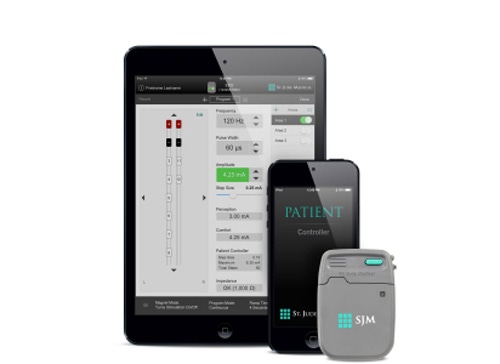In an another example of the convergence of medtech and consumer tech, St. Jude Medical's external neurostimulator tied to Apple products gains European approval.
June 4, 2015

A new device from St. Jude Medical that leverages Apple's iPod touch to help patients with chronic pain has won CE Mark, the Minnesota device maker announced Thursday.
The St. Jude Medical Invisible Trial System is aimed at helping patients decide whether electrically stimulating the spinal cord from an external devices relieves pain enough to consider a permanent implant. Patients using the system receive the external pulse generator worn under the clothing and the iPod Touch that uses wireless technology to control the device.
Other features of the iPod Touch are not activated and patients return the device after they have tried the system - the trial period typically lasts anywhere from 7 days to 2 weeks, explained Justin Paquette, a St. Jude Medical spokesman.Physicians use Apple's iPad mini tablet to set the program parameters for the external stimulating device.
The neurostimulation trial system can then deliver the treatement in both traditional and Burst stimulation modes. Burst stimulation is different from traditional or tonic stimulation in that the device delivers closely spaced, high frequency stimulation to the spinal cord and doesn’t result in the tingling sensation that patients feel during the traditional spinal cord stimulation process. The tingling sensation is known as paresthesia.
St Jude expects a broader category of people to benefit from the device given that traditional stimulation may not help some patients who can now assess the impact of Burst stimulation to manage the pain.
A key benefit from a patient perspective appears to be the ease of use.
"I expect that the St. Jude Medical Invisible Trial System will significantly improve the trial experience for my patients,” said Dr. Stefan Schu, specialist for neurosurgery and senior physician for neuromodulation at the Sana Clinic in Duisburg, Germany, in a news release. “The new system will be discreet, familiar and require no cables that can be uncomfortable or potentially cause the lead to dislodge."
The device is an example of the increasing convergence of medtech and consumer tech.
"“We’ve developed our new patient-centric Invisible Trial System as a response to physician and patient feedback,” said Eric Fain, group president of St. Jude Medical, in a statement. “The system was designed to improve the comfort and usability of our system for patients evaluating spinal cord stimulation therapy to alleviate their chronic pain without focusing on potential barriers such as programming trial cables and systems with complex trial controls.”
Arundhati Parmar is senior editor at MD+DI. Reach her at [email protected] and on Twitter @aparmarbb
[Photo courtesy of St. Jude Medical]
Stay abreast of industry trends at MD&M East Conference in New York, June 9-11 at the Jacob J. Javitz Convention Center |
You May Also Like


